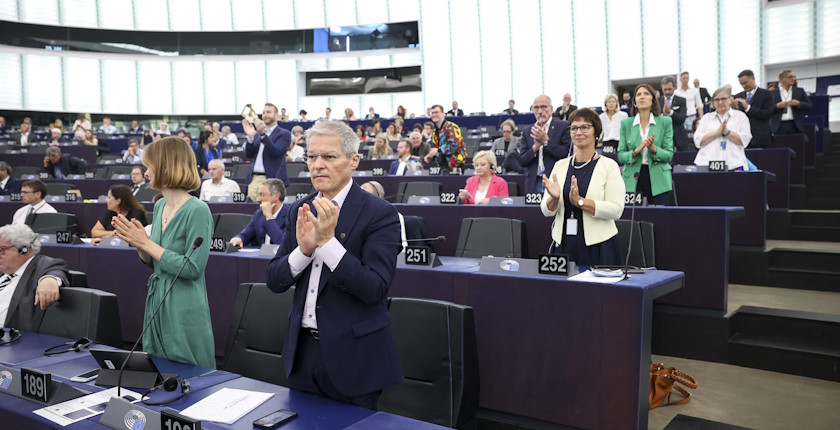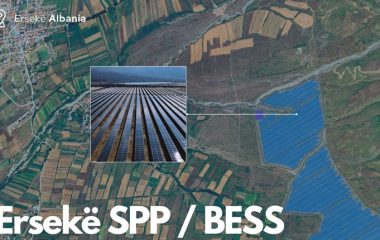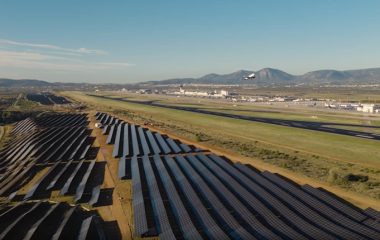
Photo: Alexis Haulot / European Union 2023 - Source: EP
By passing RED3, the revised Renewable Energy Directive, the European Parliament supported the proposal to target a 42.5% share of renewables in the EU’s final energy consumption for 2030. It compares to the previous 32% goal and the 21.8% level registered for 2021.
The European Parliament has voted to boost the deployment of renewable energy in line with the European Green Deal and the REPowerEU plan. The update of the Renewable Energy Directive, called RED3, was adopted with 470 votes to 120. The legislation was already agreed upon with the Council of the European Union, which now only leaves member states to formally put it into force.
The vote sets the binding target share of renewable energy in final energy consumption at 42.5% by 2030, but with an indicative top-up encouraging a rise to 45%. The previous goal was 32% and the measure was at only 21.8% in 2021, the last year for which official statistics were released.
RED3 is also part of the Fit-for-55 package of policy measures to cut net greenhouse gas emissions by at least 55% before the end of the decade.
Low-carbon hydrogen breakthrough
The directive was revised after lengthy and intensive negotiations. The last sticking point was low-carbon hydrogen. Almost all hydrogen is currently produced from fossil gas. The European Commission is promoting green or renewable hydrogen, which is obtained by water electrolysis using renewable electricity, as energy storage and a solution that would help decarbonize a range of industries.
The technology is still far from profitable and relies on the EU’s massive subsidies. In addition, hydrogen can be used to produce ammonia, a material crucial for fertilizers. Furthermore, ammonia, which is much easier to handle than the volatile hydrogen, can also be used as a fuel.
France and its allies have won exceptions for hydrogen and ammonia produced using nuclear power
At a late stage in talks, a bloc of pronuclear member states led by France blocked RED3. The breakthrough was achieved only after hydrogen production facilities powered by nuclear plants were partly included in the targets.
The amount of greenhouse gas emissions from the process is not much higher than with the use of renewables. Both kinds together are called low-carbon or clean hydrogen while the nuclear-only version is pink hydrogen.
As for the overall goals, the 2030 share of renewable hydrogen used for industrial purposes was set at 42%.
RED3 retains biomass subsidies
Some critics, mostly from the environmentalist front, aren’t satisfied with the introduction of go-to areas for renewables that member states need to declare. The measure is aimed at halving the deadlines for permitting in such designated zones to 12 months. The exception was made at the expense of environmental protection standards, opponents argued.
The EU will now need to slash emissions in transportation by 14.5% by increasing the use of renewables, biofuels and hydrogen. Member states can alternatively opt for a 29% target share of renewables in final energy consumption. The directive includes an indicative 2030 target of at least a 49% renewable energy share in buildings.
Environmentalist organizations claimed that shortened permitting deadlines for renewables go-to areas would undermine environmental assessments
Another ongoing dispute concerns the use of biomass, as a part of the scientific community considers it largely unsustainable. In the final text, the EU made the standards more stringent but kept the “renewable” label and subsidies.
Eurelectric, the European electricity industry’s association, praised the adoption of the proposed revision, particularly the renewables framework. It pointed out that slow licensing is “by far the main bottleneck” at the moment. Sometimes it takes eight years to get all permits while the energy plants themselves can be completed in less than four years, the statement adds.
The trade body asked decision makers in the EU for regulatory certainty, stressing that interventions in the electricity market disincentivize investments in renewables. Among other points, Eurelectric pointed to grid constraints and estimated that modernization would cost EUR 60 billion to EUR 110 billion per year.

















Be the first one to comment on this article.